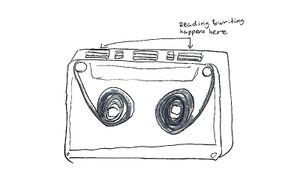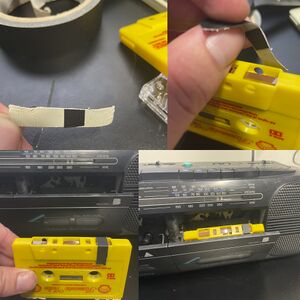(Re)Prerecording a tape
In preparation for broadcasting on Tuesday 19 September, Maria suggested producing pre-recorded, taped material to share on air. In response to this, Riviera and Victor experimented with a Sanyo Stereo Radio Double Cassette Recorder and a collection of cassette tapes.
Ideas
- Record the sounds in between different radio stations (Maria)
- Layer the sounds by covering the erase head (Joseph)
Experimenting with the Capstan and Pinch Roller Openings
In a conversation with Victor, Joseph highlighted that is possible to 'layer' recordings onto a cassette tape. This is achieved by covering the Pinch and Capstan Roller Openings on a given cassette. Whilst playing around with a the Sanyo machine Victor and Riviera figured out how to do this using masking tape.
We found out that the right-hand opening corresponds to the erase head, whilst the left hand opening is where reading takes place. By covering the right-hand opening, we were able to layer the recording. The effect of layering sounds raised questions about composition and the relationship between noise and background.
Composition
We first tried recording an amalgamation of sounds: classical music, radio signals, interference and noise. The tape became a document of what we did throughout the recording session and as such it bore a particular relationship to time. Parts of the tape feature voices, quietly talking underneath classical music. Elsewhere there are blends of classical music. Other parts feature classical music alongside radio signals. Overall the quality of the composition is a mixture of experimentation, learning how to use the technology and various effects. This also led towards questioning authorship with Victor pointing out that the sounds one receives between radio stations are multiply authored.
Hardware effects
The Sanyo device has a built in radio capable to picking up long-wave, medium-wave, short-wave and FM signals. It also has a button which switches between 'dub speed' and 'beat cancel'. Pressing this button changes the speed at which the tape plays. Thirdly, it is has a dial which filters out high and low frequency sounds. The machine does not display the amount of time which has elapsed since the tape began playing. Due to this, it is necessary to estimate amounts of time when recording.
Generating an echo/offset effect
- record recorded material onto a second tape
- record that recording onto the first tape, offset by some time.


